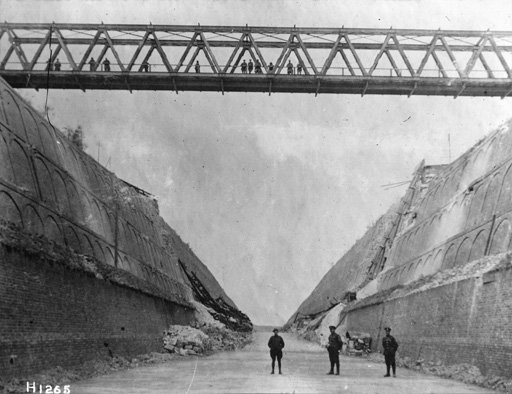The New Zealand Engineers Tunnelling Company made a significant contribution to Allied efforts on the Western Front. Their work was diverse, skilled and often dangerous and included counter-mining, communications and bridge construction.

Unknown photographer (1917) The living room of the N.Z. Tunnelling Coy. below the ground. Auckland War Memorial Museum - Tamaki Paenga Hira. PH-ALB-419-H354
Formation of the NZETC
By early 1915, warfare on the Western Front had reached a deadlock. Both sides had dug in, creating a complex network of trenches and tunnels.
Tunnels provided shelter for troops during bombardments. They also played an important role in offensives, allowing troops to safely approach enemy lines, and to lay listening devices and mines beneath enemy trenches.
Men with skill and experience working underground were in high demand. After a request from the British Government, New Zealand agreed to form a tunnelling unit. They began training in October 1915, departed New Zealand in December and arrived in France in March 1916. They were the first New Zealanders to serve on the Western Front.
The Tunnellers
The unit consisted of men with engineering and tunnelling backgrounds. They were quarrymen, gold miners from Waihi and Karangahake, and labourers from the Railways and Public Works Department. Some West Coast coal miners also joined, despite mining being an essential occupation and therefore not subject to military service. The officers were trained civil engineers, largely drawn from the Public Works Department. At least two were founding members of the NZ Society of Civil Engineers. The unit comprised 16 engineering officers, 407 other ranks and attached medical, service and pay corps, a total of 446 men.
Initial Operations
The tunnellers first weeks on the Western Front were spent in La Havre, where they were involved in counter-mining operations. They raced to lay mines beneath the enemy lines, before the enemy could do the same to them.
They were then deployed to Arras.
Operations in Arras
A large British advance around the French town of Arras was planned for the late spring of 1917. The NZETC turned its attention to the expansion of existing underground quarries in the area to support the advance. Expansion of the caverns and development of a tunnel network would allow troops to pass safely into no man’s land near the German front line. Extensive communications and service tunnels were needed to support these operations.
The NZETC, along with New Zealand and British infantrymen and 43 men from the New Zealand Pioneer Battalion, worked 18-hour shifts, seven days a week for several months. Some 41 men died and 151 were injured in counter-mining operations by the Germans, seeking to disrupt the underground works.
The chalky rock was easy to tunnel, and the scale of the work was enormous. To assist navigation through this vast network of tunnels, the NZETC gave New Zealand place names to different sections, stretching from Russell in the north to Bluff in the South.
By the end of January 1917, most of the expansion work was complete and the men started to install services, direction signage and tramways to assist troop movements. By this stage, the combined underground works in the area could accommodate 24,000 men, used 20km of communication tunnels, had its own power, water and latrine systems and fully operating medical and command centres.
The Arras offensive began on 9 April 1917, with the detonation of a 1,000kg mine laid beneath German trenches. The potential of the tunnels, was however, limited by the German withdrawal to the Hindenburg line two months prior.
The unit stayed in Arras until July 1918, constructing further underground shelters. Other work included trench expansion and communications.
Havrincourt Bridge
The Battle of Havrincourt started on 12 September 1918, with the German retreat to Belgium. On September 28, the unit was ordered to construct a bridge across the Canal du Nord. The bridge was a steel truss assembled on site and then rolled across the canal. It was constructed under fire and when completed, was the longest bridge on the Western Front. Later that autumn, the unit built more bridges over a canal and rivers near Le Quesnoy.

Steel Bridge built by tunnelling co NZ engineers, 1914-1918, Auckland War Memorial Museum - Tamaki Paenga Hira. PH-RESOS-133
Armistice and Return Home
After the Armistice was declared on 11 November 1918, the unit stayed in France building bridges, but their skills were also urgently needed at home and they were demobilised with all possible speed. The unit crossed the Channel to Great Britain on 30 January 1919 and embarked for New Zealand on 14 March. The last men arrived back in Auckland on 23 April 1919 and the unit was officially disbanded the next day.
Memorials in New Zealand
A formal memorial to the NZETC was unveiled at Gilmour Lake in Waihi on 22 January 2016. It is accessible by foot from the carpark off Gilmour Street.
In Wellington, the Arras tunnel, under Pukeahu National War Memorial Park, opened to traffic on 29 September 2014. The tunnel was named to commemorate the New Zealand Tunnelling Company and their work at Arras.
Memorials in France
The tunnels beneath Arras were closed after World War II and rediscovered in 1990. The Wellington cavern now houses an underground museum and memorial: La Carriere Wellington, Memorial de la Bataille d’Arras.
More Information
Auckland Museum. The underground war. Auckland War Memorial Museum - Tāmaki Paenga Hira. First published: 10 March 2016. Updated: 27 March 2016. URL: www.aucklandmuseum.com/discover/collections/topics/the-underground-war
Byledbal, Anthony. New Zealand Tunnelers website. First Published 2009. URL: www.nztunnellers.com/history
Ministry for Culture and Heritage. 'Tunnelling Company'. Updated 4-Apr-2019. URL: nzhistory.govt.nz/war/specialist-units/tunnelling-company
Ministry for Culture and Heritage. 'What New Zealander's left behind in Arras, France.' First published: 22 September 2014. Updated: 26 September 2014. ww100.govt.nz/what-new-zealanders-left-behind-in-arras-france
Ministry for Culture and Heritage. 'Zoomable Arras tunnels map'. Updated 22-Mar-2017. URL: nzhistory.govt.nz/media/interactive/arras-tunnels-map
Radio New Zealand. 'Memorial to honour NZ's WWI tunnellers'. Published: 22 January 2016. URL: www.radionz.co.nz/news/national/294664/memorial-to-honour-nz's-wwi-tunnellers
Waihi Arts Centre and Museum. 'The New Zealand Tunnelling Company.' URL: www.waihimuseum.co.nz/museum-and-research/waihi-history/the-nz-tunnelling-company
Page last updated 1 May 2019
